Project Lightning is Virgin Media’s latest expansion of their network, potentially passing 4 million extra premises, a large portion of it will break away from the traditional hybrid fibre-coaxial network and change to radio frequency over glass and FTTP.
The installation took about 2 hours and was similar to an ordinary coaxial install, the CPE are the same as legacy installs but there’s now a larger “omnibox” that houses the incoming fibre and powered RFoG node.
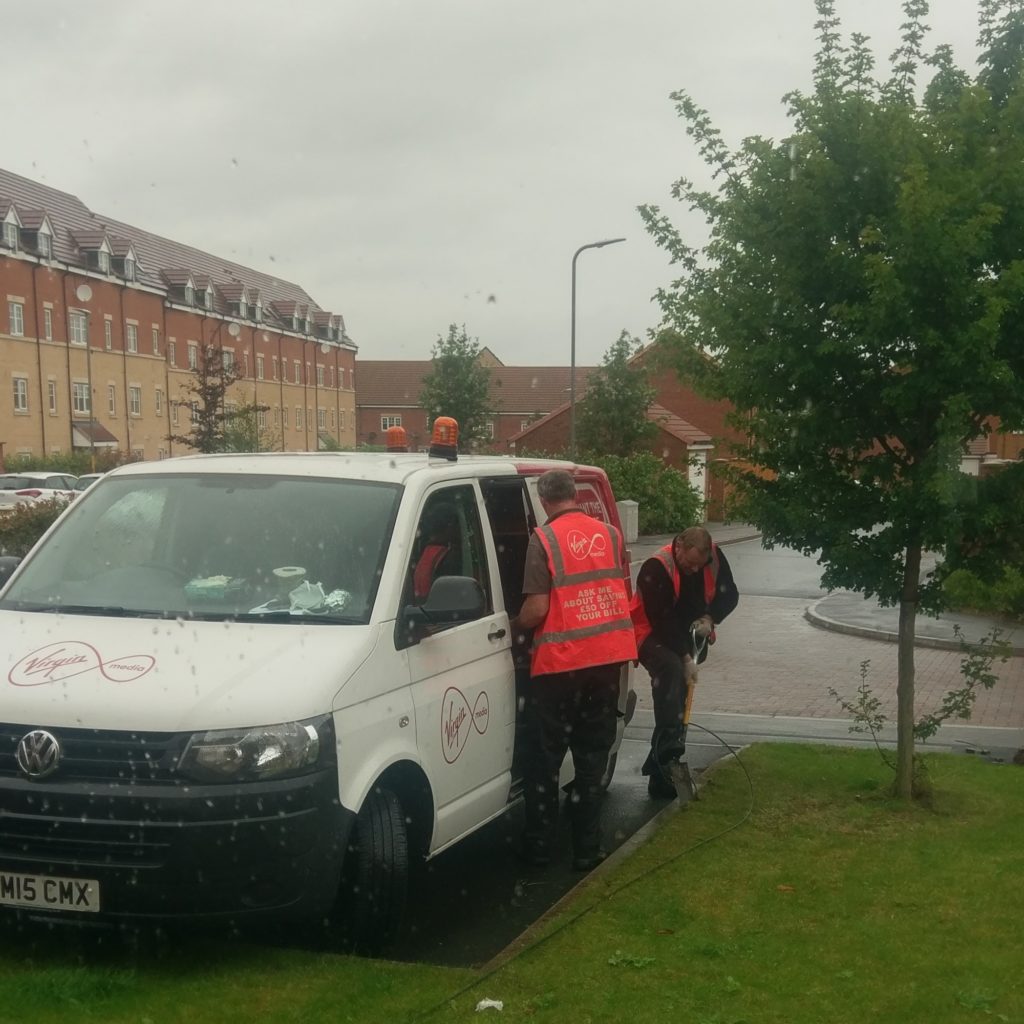
The microduct contains the blown fibre, but it is only installed “spade depth” in the ground which could cause problems in the future if you were to change the surface.
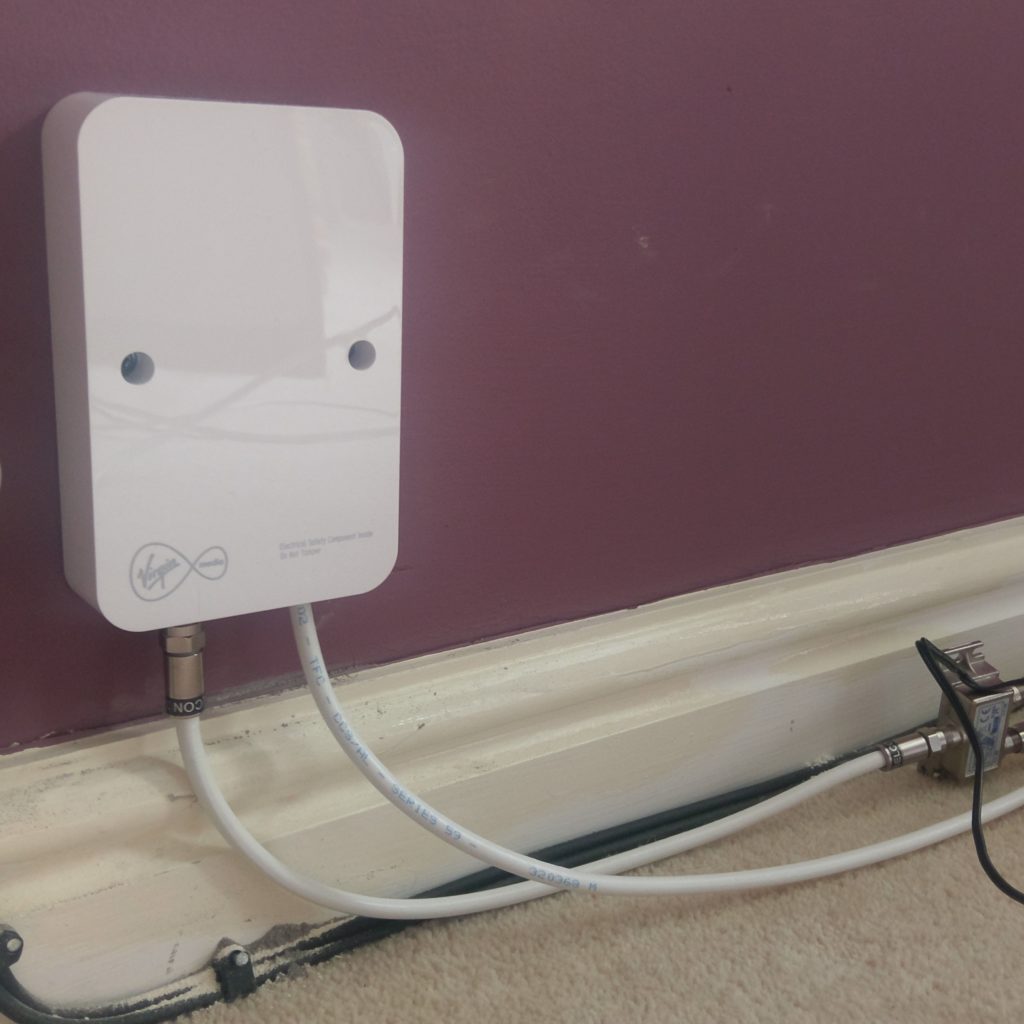
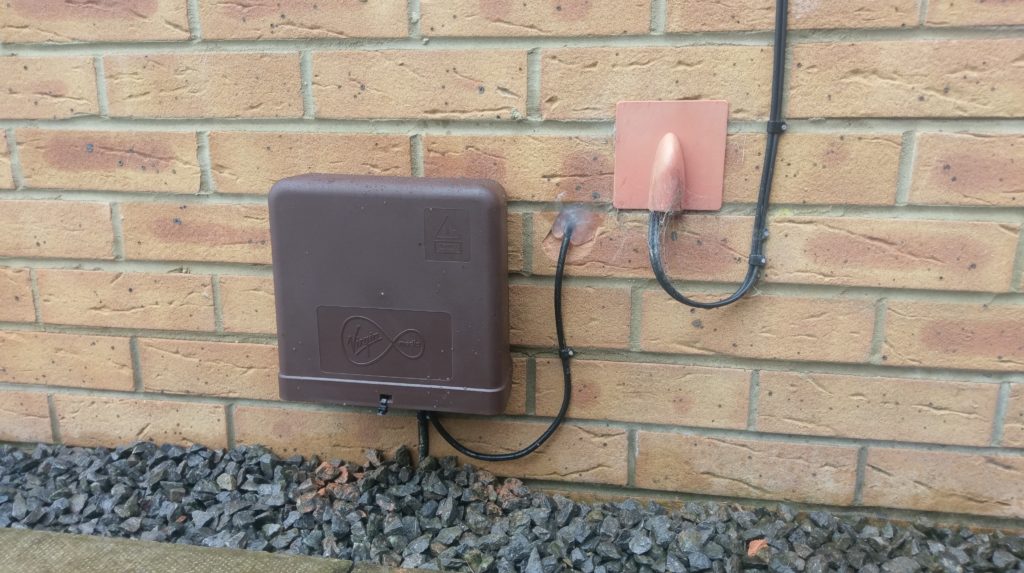
The external wall box is bigger than before, it houses the fibre which is pre terminated at one end with an SP/APC connector and blown to the local distribution cabinet where it is then spliced into the rest of the fibre network.
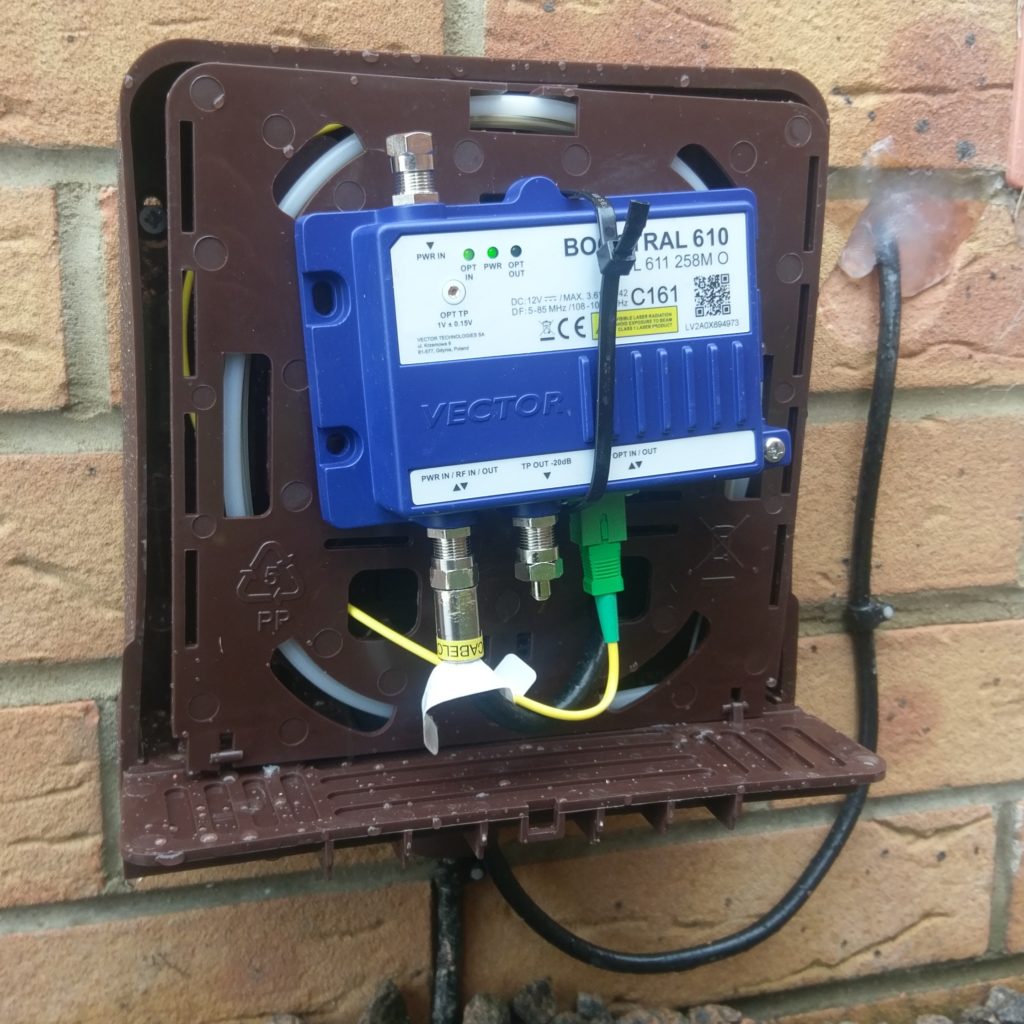
The RFoG node is a Vector BOOSTRAL 610 (superseded by the Vector BOOSTRAL 711) Which is IP42 rated for external use, the wall box cover doesn’t have a rubber seal and slides over the wall mounted piece, time will tell if it can stand the elements!
Vector BOOSTRAL 610 Data Sheet
If you’re interested, the Virgin Media Project Lightning Developers Guide shows a lot of the technical detail that makes up the local side of the new RFoG network.

I went for VIVID 200, a nice upgrade over the previous FTTC which topped out at about 30Mbps, we’ll have to see how things go as more and more customers are added to the network.
If you’ve got any questions about the install, head to the comments section below.
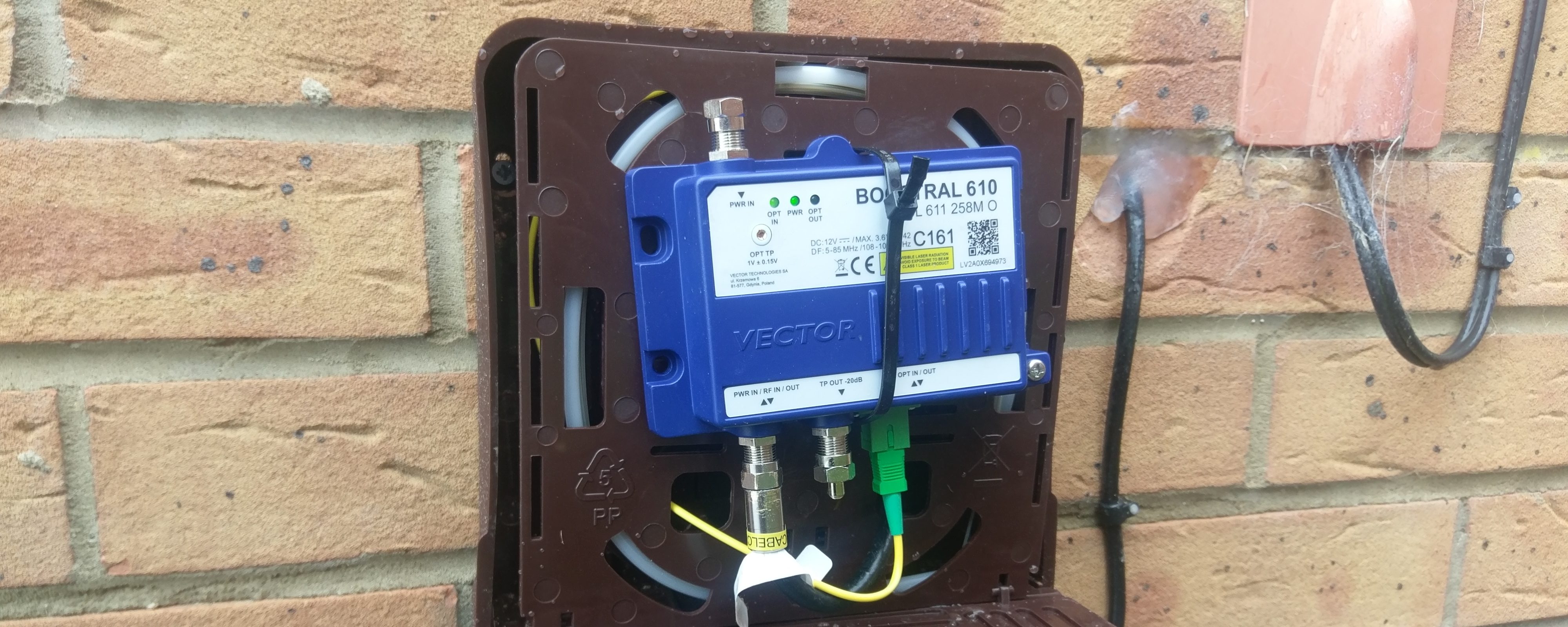
Hello Richard,
Thanks for this. It took me two hours of googling to find your excellent description.
Perhaps you could be so kind as to answer three quick questions.
1. Was the install done in just one visit? I have never been a Virgin customer before and from what I have read they normally have a team that arrives to install a cable from the “T on the pavement to your omni-box then some time later another person arrives to run a cable from the omni-box to your internal wall box.
2. I have seen very few tidy Virgin installs. Not surprising as I guess the installers are paid per install and not per hour. To save running cables all around the outside of the house I will run the coax up the wall, through my loft, then down the other side. I know the Virgin installer won’t go in my loft (I will do that) but I would like to pre-drill access holes in my soffit. So what is the external diameter of the coax cable from the omni-box to the internal wall box?
3. The micro-duct from the street cabinet to the “T” on the footpath at the boundary of my property has been laid and is green and about 1cm in external diameter with an internal hole of about 1/8” in diameter (sorry about mixing imperial and metric). How is this joined to the black micro-duct that runs from the “T”, under your lawn, to the omni-box. This seems a smaller outside diameter as far as I can see from your photographs? Any chance of opening up the lid of your “T” and posting a photograph of that join?
Thanks
Trefor
Quick question, looking at getting VM in a RFOG lightning area (so no phone available), have you kept BT, or are you using VOIP?
Hi Phil, I didn’t keep my old line, I’ve not really got any need for a landline and just as you’ve found out it wasn’t available at the time of ordering!
However, I noticed recently that in the hub config pages the status of the RJ11 sockets changed from “Disabled” to something more along the lines of “Active”, so I wonder if it’s now available in my area.
VM do some strange things, no VoIP available at launch and even though we’re on a new network segment the CMTS we’re connected to doesn’t support anything higher than 200MB, we can’t order 300MB, but people two streets away on the older hybrid network can!
Phil, I am moving to VM in a few weeks. It’s a new FTTH install. Irrespective of whether VM can offer a telephone service I have gone with VoIP. I chose Sipgate that I have now tested on a BT HomeHub4 router and an Asus router and it works fine. Sipgate have no monthly fees and you just pay for calls. Though I think you have to use the service every so often (I think at least every three months) otherwise they cancel the service. Some people have had problems with VoIP and the normal solution is to disable ALG. BT HomeHubs don’t allow you to do this. Nor does the Superhub that VM supply. My Asus router does. But the service so far works fine with both routers and I have not had to disable ALG on the Asus. I think VoIP becomes a problem with ALG if you have multiple SIP accounts with multiple providers.
For an ATA I chose the Grandstream HT801 which has been fine for me. The cheapest seller I could find was netxl. When it arrived I found it was a “white box” version which seemed to be preconfigured for their own VoIP service. But is was no effort to change the settings. Settings for Grandstream ATAs are on Sipgate’s website. In addition to what Sipgate said I needed to do, I changed SLIC settings to “UK” and Caller ID Scheme to “SIN 227 – BT”.
Interesting article.
VM have installed fibre up to the house here, so do you think they have an upgrade path to move to full FTTP speed or have they just used fibre instead of coax because it’s cheaper ?
Hi Simon, good question. I believe they do, but (and this is just a guess) I think the speed increases won’t all come at once, they’ll base it on commercial need.
If G.fast is only going to be topping out at 330Mbps and there are only a few other accessible FTTP providers why would they immediately offer say 500Mbps when they can just keep ahead of the competition and drip feed new tiers as and when they need to.
Their priority at the moment is to move their network and customers from EuroDOCSIS 3.0 to DOCSIS 3.1 which has a multi-gigabit future, rather than topping out at around 1Gbps. You can do DOCSIS 3.1 over HFC, they’re just future proofing the network by installing fibre, you can keep upgrading fibre every few years by changing the laser technology at the ends and in the middle!
Great guide. Just wondering, what exactly is in the internal Virgin box? Is it just a splitter (similar to one in the bottom right of photo) that allows the RF and Power on the ONU outside to be on a single socket (rather that running 2 cables in)
Thanks! You’re exactly right, it’s just a splitter so only one cable comes through the wall.
Some virgin internal wall box do not have the power adapter. There is straight connection from the box to the Hub. What is the difference between the two?
Could this be a legacy, plain old RF install? There would be be no RFoG media converter that requires power in those installations so just one cable comes through the wall carrying the RF signal straight to the Hub.
Probably is but I was wondering which one is better? The powered internal boxes or the legacy RF installation?
Excellent article, understand further especially due to the issues I’m having .. broadband low speed, TV pixelating (Chan4,E4, Sky) all in last quarter of 2023, then damaged external box from recent storm after VM engineer said he fixed it into place prior to storm.
I wonder if I get newer external/internal box replacements as in your article and upgrade in BB service 150 to 250mb or 350mb at a negotiable cost, replacement of Hub 3 to Hub 4 … wishful thinking all round